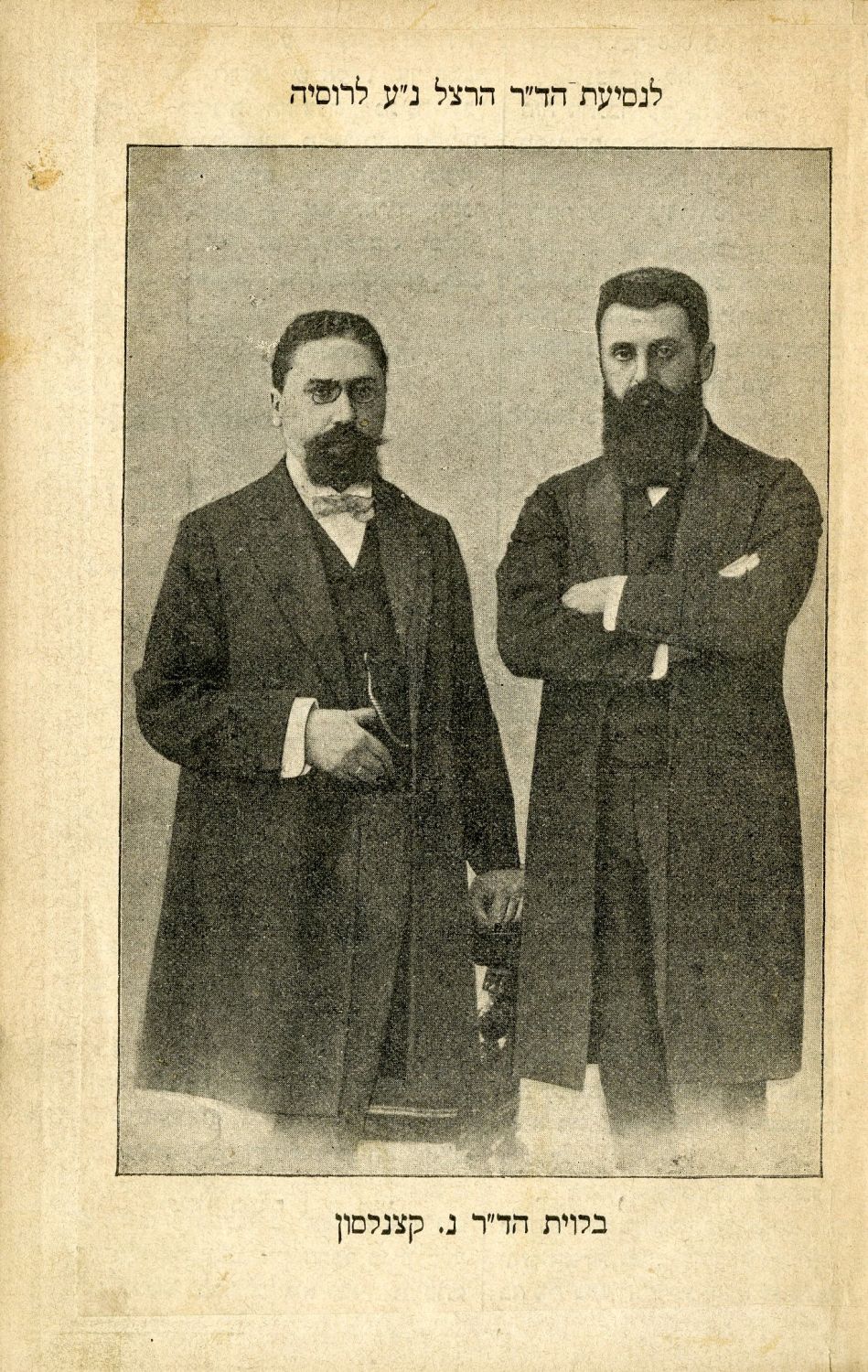
Volume compiling six booklets published by "Achiasaf" in Warsaw (and Berlin) in the late 19th century, in the series "MiZman LeZman" ("From Time to Time") edit by Achad Ha'Am (Asher Ginsberg). Apparently all the booklets that were published in this series. On the first page (before the title page of the "Basile Congress") appears a rare photo of Theodor Herzl "with Dr. N. Katzenelson, who accompanied Dr. Herzl to Russia".
appear:
• The Basel Congress, by Dr. Theodor Herzl, translated by Michal Berkovich [1897]. First edition in Hebrew of the summary of the First World Zionist Congress as written by Herzl himself.
• Al Zion VeAl Mikraia - about the history of the Zionist movement, by Shaul Pinchas Rabinovich. (1898).
• Ideas about the second Zionist congress, by Dr. Mordechai Ehrnpreis. Berlin, [1898].
• Zionism in Jewish history, from the Spanish Exile until the present day, by Ben-Avraham [Ben Zion Katz]. [1899].
• Our literature, opinion as to the development of our language and our literature, by Dr. Shimon Bernfeld, [1899].
• Judaism and the Diaspora, by Ze'ev Yavetz. [1900].
Ex - libris of Rabbi Yehuda Leib HaCohen Maimon.
Some pages are detached. general condition good.

Two early publications of impressions of internal scenarios from the discussions and conclusions that emerged at the second and third congresses in Basel.
Kneset HaGdola or the Zionist Congress in Basel, edited by Nachum Slushetz (members of the Congress). "Tushiya" Publishing House, Warsaw, 1898. "Details of all the proceedings of the Second Congress in Basel, the meetings, the negotiations, the speeches and the decisions". In his words, the author writes in the introduction: "My intention is to present to the reading public the occurrence of the Congress Chronicles in detail and to find out from them in particular all these cases and visions and things that have an existing value for generations." Among other things, the author provides documentation for rare historical scenarios that accompanied the behind the scenes of the Congress in personal discussions that took place between the various delegates that led to fateful decisions that were made at the Second Zionist Congress in Basel. Includes a one-of-a-kind description of the "Sabbath of the Congress" - the assembly of the deputies in the synagogue on Shabbat and Theodore Herzl's Aliya LaTorah.
The Third Basilian Congress, by S. Rozenfeld. "Ahiasaf" publishing house. Warsaw, 1899. "The program adopted at the Third Congress, what does it say: "All we have done now is to get a "charter" under the high government of His Majesty the Sultan, when we will have the same "charter" in our hands to engage in mass colonization." The author often praises Theodore Herzl who: "knew how to penetrate the depths of the soul of the nation... As his knowledge of this grew, so did his affection for his people... Herzl is a man of great strength of heart, a man who pours out his government... and will force the entire people to surrender to his discipline and to be a servant to his will..."
Both books belonged to Rabbi Yehuda Leib HaCohen Maimon Fishman with his Ex-libris. general condition good.

"Der Zionist" - "Lovers of Zion" company, two issues - June, July 1898.
Early pamphlets that came out in New York, and accompanied the Zionist activity that took place in Europe, the issues dealt with the goals of Zionism, Theodore Herzl, the national awakening, the attitude to religion, and more. At the end of the sheets are advertisements for Jewish businesses.
complete sheets. Good condition.

Herzl's life and actions by By Shmuel Leib Citron, was published to mark the half-year anniversary of the publication of "The State of the Jews" in print, published by Sh. Sherbarak, Vilna 1921. Second edition with the additions of the congressional speeches.
A rare book about Theodor Herzl. At the beginning of the book there boards with 15 photographs of Theodor Herzl starting from his childhood, a photograph of Herzl's sons, his grave, and his funeral procession. In this edition, the author added a full transcript of Herzl's speeches in the first to fifth congresses (five speeches in total, translated into Hebrew).
[21], 6-221, [2] p. 23 cm. Good condition.

Three photographs of Jews near Herzl's grave in the old cemetery in Vienna, of which two are group photographs.
Herzl wrote in his will that he wanted his bones and the bones of his family to be brought to Israel: "I ask that they bury me in a metal coffin next to my father, and lie there until the Jewish people move my body to the Land of Israel...". The will was executed in August 1949, when his bones were brought to Israel. Until that time, many of the Jews who came to Vienna and the surrounding area used to go up to Herzl's grave and take pictures next to the tombstone. As it can be seen in the photographs, three names were inscribed on the tombstone, and three bronze coffins were placed in the grave one on top of the other in the order of their death, Herzl's mother, Herzl himself, and his father. In August 1949, all three coffins were brought to Israel.
Same size: 9x7 cm. Good condition.
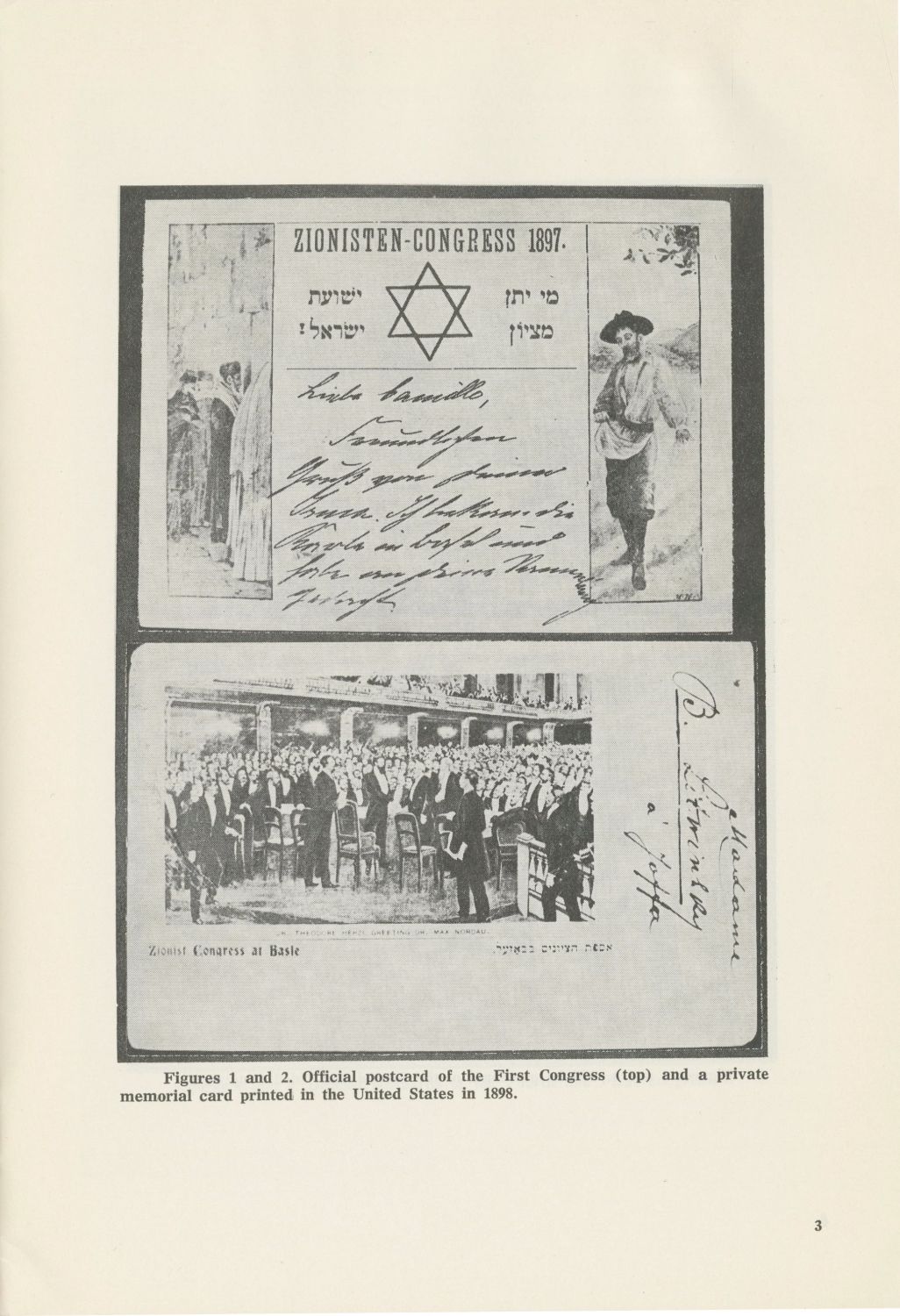
The Official Postcards Cancellations of the Zionist Congresses - An important catalog of the official Zionist Congress postcards that were published on the occasion of their existence - starting from the first Zionist Congress in 1898 until the Congress held in 1978, by Prof. H. RIEMER (from Switzerland). Published by The Society of Israel Philatrlists, Ohio 1980.
The catalog presents photographs of the official postcards issued in each Congress, starting with the first, and distinguishes between commemorative postcards and official postcards. Also, if there were congresses in which no official postcards were issued, they will not appear in the book (as the introduction specifies the difference between official postcards and souvenir postcards, as well as the congresses in which no official postcards appeared). The author even distinguishes between official postcards and ordinary postcards with special postmarks issued for the occasion of the Congress, and adds important details in this matter in the introduction.
36 p. Very good condition.

A photograph of Haim Nachman Bialik during his visit to Kovna in October 1930. The guy standing to Bialik's left is Aharon Pertsikovich, a youth in a Jewish youth movement who accompanied Bialik on that visit. On the back of the photograph is an ink stamp of "Society for the History and Ethnography of the Jews in Lithuania".
For another photograph of Bialik from the same visit see here
10x8 cm. Slight loss in the lower right corner. Very good condition.
Attached : a photograph of a girl next to a tombstone that was erected in memory of Bialik in Ramat Gan in 1939. On the tombstone is written: "A tribute to our poets H. N. Bialik... Ramat Gan 1939". (Bialik moved to live in Ramat Gan in 1933, where he spent the last year of his life, while often walking on one of the hills in the city. "Here I found the rest I was looking for, " he said. Sitting in this place, the fresh air and the view of the sea, inspired him. It is said that he wrote his last two poems: "Farewell" and "Widows". In 1939, on the fifth anniversary of his death, the Ramat Gan local council erected a bench in his memory on which is written: "A tribute to our poet H.N. Bialik, a place he chose for his walks on his Sabbath days In Ramat-Gan, 1939"| - this is the bench that appears in the photograph before us).
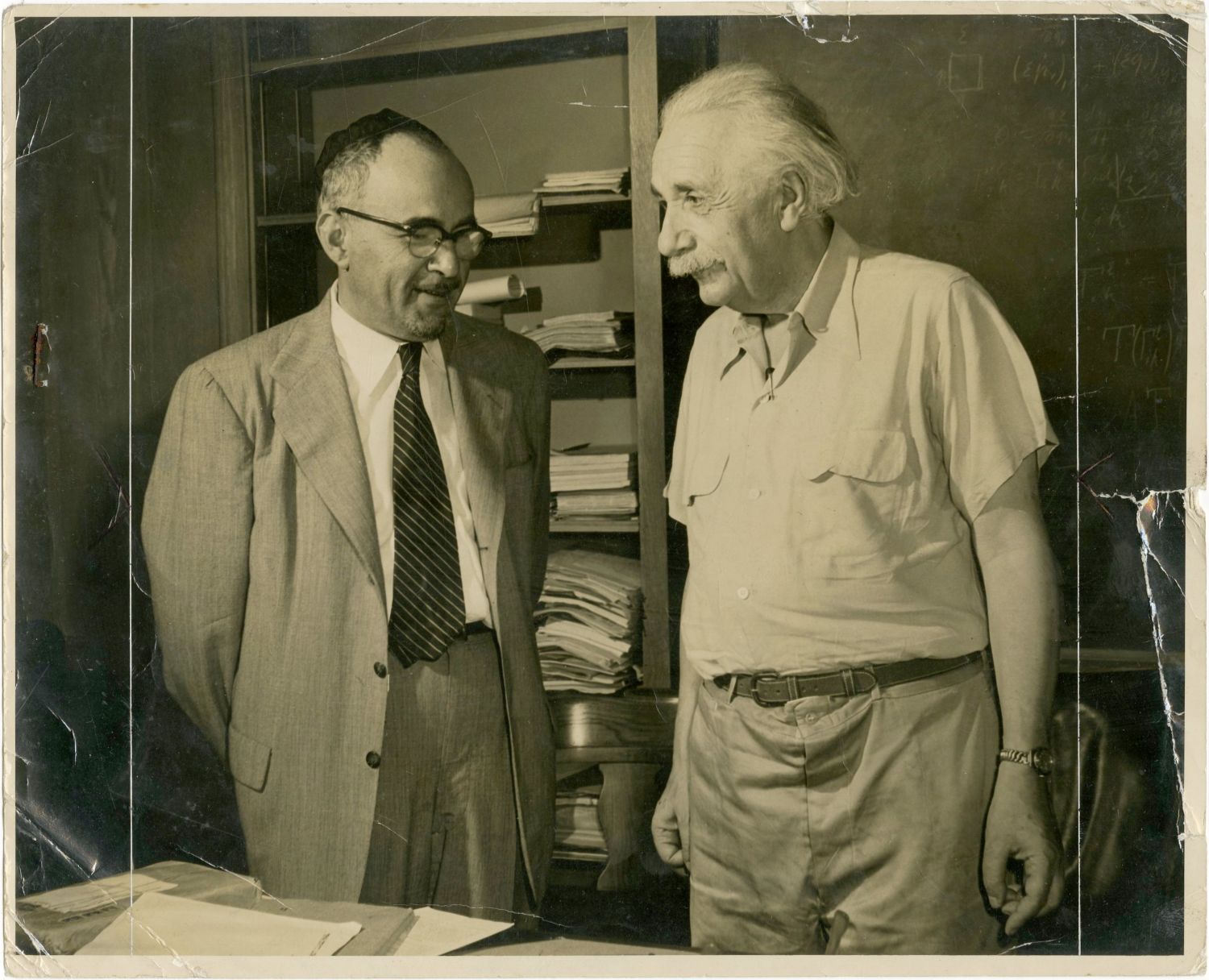
A large photograph of Albert Einstein talking with Dr. Shmuel Belkin, president of Yeshiva University in New York. Taken in 1953 as part of an event where Einstein was invited on the occasion of the establishment of the "Albert Einstein College" of Medicine at the Yeshiva University. Signed on the back with the ink stamp of: "DEPARTMENT OF PUBLIC RELATIONS YESHIVA UNIVERSITY NEW YORK", as well as a paper label pasted on the back of the photograph with a description of the two. Photographer: Herbert Sonnenfeld.
Back in 1945, the president of the yeshiva university, Dr. Shmuel Belkin, foresaw the establishment of a new medical school. With the encouragement of influential public figures, he convinced the board of trustees to initiate discussions with the New York State Board to amend the university's charter to include the awarding of a Doctor of Medicine degree, And the discussions were successfully completed on December 15, 1950. In June 1951, Dr. Belkin and New York City Mayor Vincent Richard Impellitteri entered into an agreement whereby the professional care of all patients at the Bronx Municipal Hospital Center would be the responsibility of the College of Medicine faculty.
On March 15, 1953, the day after his 74th birthday, Professor Albert Einstein officially agreed to allow his name to be used for the first medical school to be established in New York City since 1897. Einstein was invited to the honorary event of the naming the institute after him, and then the photo before us was taken. Since then, the center has been refined, and additional wings and buildings have been added.
for the film dealing with the establishment of the Albert Einstein College at Yeshiva University, as well as the part of the university's president, Prof. Shmuel Belkin, in the establishment of the school see here . The film includes footage of Albert Einstein at a press conference held in 1953 announcing that the new medical school would bear his name. Then-Senator John F. Kennedy is photographed looking at an architectural model of the school. also see here Another video that came out about Dr. Shmuel Belkin and that important event. (Rabbi Professor Shmuel Belkin [1911-1976] is a scholar of Jewish studies. The second president of "Yeshiva University" in New York. Belkin was born to Rabbi Shlomo and Mina in Sbisluch, Poland. When he was eight years old, his father was shot and killed by a Polish policeman. In his youth he studied at the Mir and Radin yeshiva and was ordained to the rabbinate at the age of 17. In 1929 he immigrated to the United States, and on May 23, 1944, he was appointed president of the "Yeshiva University". One of his quick successes was obtaining university status for the Yeshiva from the State of New York. He also was a board member of dozens of educational, scientific and public institutions, including the Union of Orthodox Rabbis in the United States and Canada, the American Rabbinical Association, the Religious Zionists in America, and more).
25x21 cm. Slight tears (reinforced by pasting paper on the back). Cracks. Good condition.

SANG OCH BON ... GUSTAV IV ADOLPHS - A song and blessing to King Gustav IV Adolf by Judifka Forfamlingen on behalf of the Jewish community. Stockholm 1796. Swedish.
Gustav IV Adolf (1837-1778) King of Sweden from 1792 until his abdication in 1809. The period of his reign is considered one of the best periods for Swedish Jewry.
[8] p. 19 cm. Thick paper. Very good condition.

צירקולאר אן דיא לעבליכען מיטגלידר דער יודנשאפט צו בערלין, וועלכע בייאטרעגע צור געמיינדע קאססא צו ענטריכטען האבן - 'Returning to the members of the Jewish community in Berlin...'. Berlin, Cheshan 21, 1811.
Single leaf - proclamation regarding the regulation of tax payments related to the seats in the synagogue in the Jewish community in Berlin. Signed in print the leaders of the Berlin community, including David Friedlander.
[1] leaf. 33x21 cm. Thick paper. Tear on the left with no text damage. Good condition.

"Our brother Beit Yisrael" - An appeal to the Jewish public to help the Jewish community in Saxony after a fire occurred in the synagogue of the community, Germany, 1858. German and Hebrew.
The writer describes the fire that broke out in the synagogue in the German language, and adds verses in Hebrew: "ממרום שלח אש בעצמותי נפלה עטרת ראשנו", as well as "ואהיה להם מקדש מעט אלו בתי כנסיות ובתי מדרשות". At the end attached the opinion of the local leadership which confirms the damage that happened to the synagogue.
[3] pages. Tear along the page with no text damage. Good condition.

"Or Zaru'a…poem…in honor of Karl Ludwig…brother of our king Franz Joseph I, by Yossef Cohen Zedek". Lvov (Lemberg), [1854]. Hebrew, with an introduction also in German.
Long poem in honor of the prince, Archduke Karl Ludwig, the younger brother of Franz Joseph I, Emperor of Austria. Including a title page and comments in German.
28, [7] pp., 21 cm. Stains and creases. Good condition.

"Ateret HaChayim" - a single page prayer for the healing of the benevolent baroness Clara de Hirsch wife of Baron Maurice de Hirsch. Kushta, Tevet 1898.
The page opens with verses of mercy. In the following, a unique prayer especially for her healing "May my heavenly heaven send a long healing... to the righteous spirit and soul that became known in the gates of her deeds, the happy lady Mrs. Clara Di Hirsch... and her soul will not go down..."... (The baroness died shortly after).
Baroness Clara de Hirsch, wife of Baron Maurice Hirsch, a German Jewish tycoon and philanthropist who lived in France, England and the Austro-Hungarian Empire. Through the YKA company he founded, he assisted in the organization and finances of the great immigration of Eastern European Jews to America (and mainly to Baron Hirsch's colonies in Argentina) at the end of the 19th century. His meeting with Theodor Herzl, in 1895, opened Herzl's activities for Zionism. Under the influence of his wife Clara, Hirsch devoted a significant portion of his time and wealth to the well-being of his fellow Jews in the places where they were persecuted and oppressed. He was heavily involved in the activities of "Alliance". His wife, Baroness Clara de Hirsch, continued his generous charity. The total of their contributions over the years was estimated at £18,000,000, according to the values of the end of the 19th century. Among other things, she was known for her donation to the former Hirsch Hospital, she spent 200,000 gold francs to establish the hospital that would serve the needs of the Jewish community. The building was opened in 1908 and operated until 1941. After the liberation, the Hirsch Hospital was used by British military units and the Greek Red Cross, until 1950. Today it is one of the largest public hospitals in Greece. Baroness Clara de Hirsch died in Paris on April 1, 1899.
[1] page. 34x24 cm. Filing holes. Missing tears along the middle fold line with minor text damage. Tears in the margins. moderate condition.
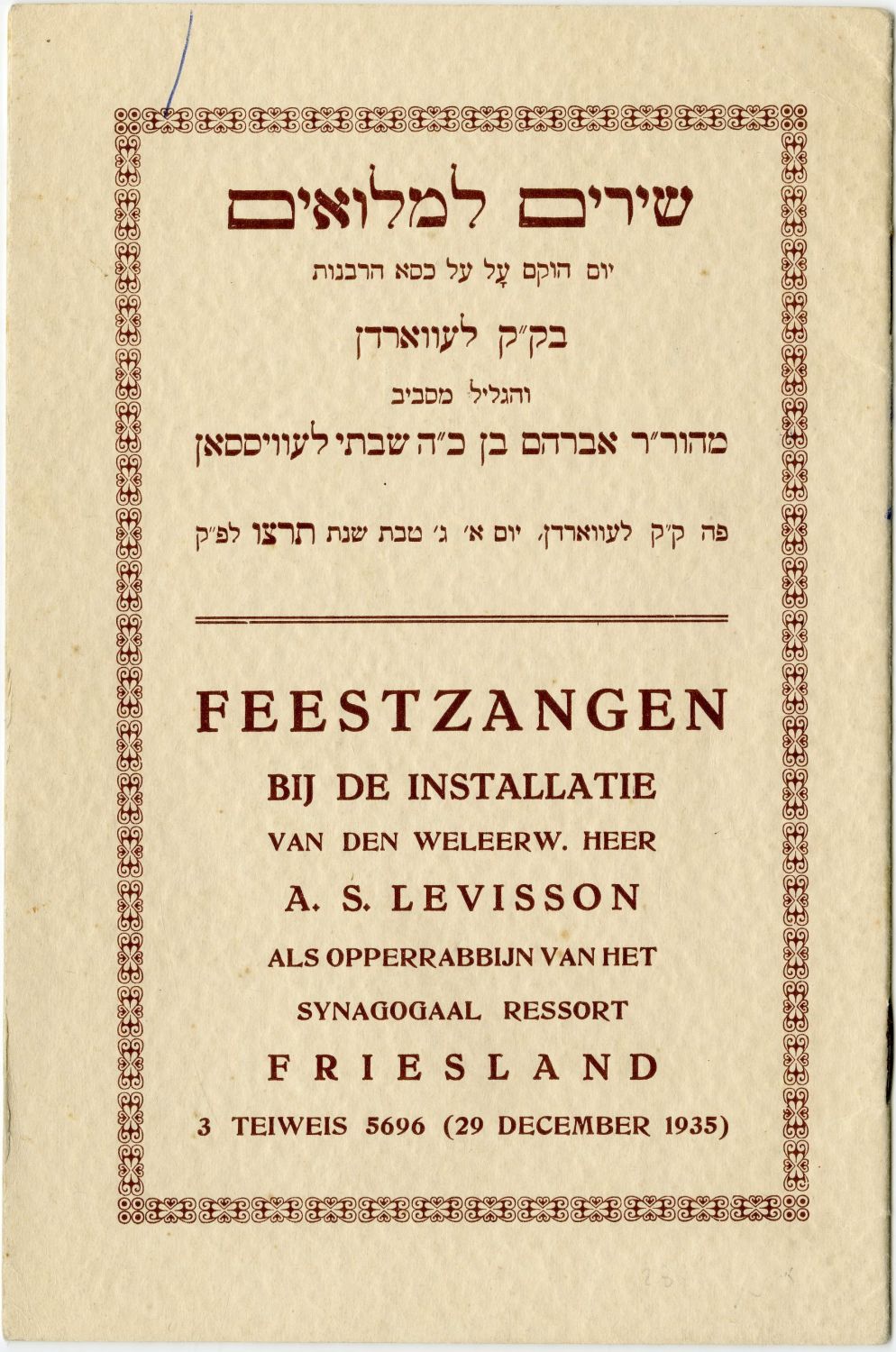
FEESTZANGEN BIJ DE INSTALLATIE VAN DEN WELEERW. HEER A. S. LEVISSON ALS OPPERRABBIJN VAN HET SYNAGOGAAL RESSORT FRIESLAND - Sirim LeMiluim: The day was established on the throne of the rabbinate in the KK Leeuwarden and the surrounding Galilee Rabbi Avraham son of Rabbi Shabbati here KK Leeuwarden, Sunday, 3rd Tevet of the year 1935 ... - a booklet containing songs of praise in honor of the appointment of Rabbi Avraham Shabti Laevissan to the rabbi of the Leeuwarden community in the Netherlands. Also a prayer for the peace of Queen Wilhelmina of the Netherlands. Hebrew and Dutch page by page. Amsterdam December 1935.
[8] p. 23 cm. Very good condition.

Three secret minutes of meetings in which fateful issues were discussed in the struggle of the Zionist leadership to establish a Jewish state in the Land of Israel, Detailed discussions regarding the structure of the future jewish state, and the role of Jewish law in it, action plans against the riots of the Arabs, fateful discussions on the issue of European Jewry and bringing it to Eretz Israel, The action against British rule in the Land of Israel, and more. London, and Eretz Israel, The 1930s.
"Strictly confidential" - the decisions of the administrative committee of the Jewish Agency made at a meeting that convened in London on the 23rd - 27th of March 1930. A summary of the decisions of the agency's committee regarding Jewish-Arab relations in palestine. The report, which was printed on a typewriter under the heading "Strictly Confidential", opens with the statement that: "The Jewish Agency declares... that on the question of the relations between the Arabs and the Jews, it holds the political position... which reinforces the "desires of the Jewish people in the Land of Israel to live with the Arab people in harmony And in a relationship of mutual respect, and together with them will make the country to a flourishing country, which will guarantee to every nation an undisturbed national development without disturbances". Later on, there are sections that determine the right of the Jewish people "to establish our national home in the Land of Israel, and on the condition that the Jews do not rule over the Arabs nor The rule of the Arabs over the Jews...", as well as the guarantee of the right of Jewish immigration, the expansion of the foundations of self-government, the establishment of a social constitution, the regulation of financial matters, the roles of the Jewish Agency in the Land of Israel, and more. 7 Typewritten pages, 34 cm. Filing holes, good condition.
"Secret Meeting No. 61" - The Palestine Partition Committee, all details of a meeting held on September 13, 1938, at the committee's offices in London. The minutes include the words of Rabbi Herzog, Rabbi Dr. Hertz, and Rabbi M. Berlin, president of the Histadrut HaMizrachi. Rabbi Herzog went on to explain the Jewish Halacha's view of a "Jewish state", and the role of Torat Israel in the future Jewish state, and responds to the concerns that were raised in that Meeting that the Jewish state will be completely subordinate to Torat Israel, there is a discussion about kashrut, and the sending of kosher Mashgichim to the concentrations of the immigrants, a long discussion about "religious" clauses that were supposed to be included in the constitution of the State of Israel when it was established, as well as the delicate relations between the Jewish Agency and the Israel Association. 11 pages typed on a typewriter 33 cm, filing holes, good condition.
"secret". about the political situation. The words of Mr. M. Sharetuk (Moshe Sharet) at the assembly of elected representatives of the Knesset of Israel in the Land of Israel held in Jerusalem on Monday, 8.17.1936. A full transcript of Moshe Sharet's opening lecture, in which he elaborates on the violent struggle for the land, increasing the power of the "Jewish police" and increasing recruitment, Laying the cornerstone of first Jewish port in the Land of Israel - the port of Tel Aviv, the future dangers from the "Jewish-Arab riots", and answers to the claimants that the leadership is not doing enough against the riots of the Arabs in Israel, asking for help from the Jews in the diaspora, and re-regulating the relations between the Jews and the British in the Land of Israel. 15 typewritten pages, 32 cm. Good condition.

An anti-Semitic poster stating restrictions on movement and trade on Christian holidays. Italy, 1769. Signed in print in the name of Baron Friedrich Karl.
As part of the tightening of the Christian dogma and the granting of valid powers to the church, in the decree before us restrictions were announced on the Jews on the days of the Christian holidays. The regulations state that on Sundays and Christian holidays, the Jews will be prohibited from engaging in any public activity such as sleigh rides, performances, dancing and singing in public, and gatherings of any kind are prohibited. It was also determined that the Jews will be completely prohibited from engaging in trade, the Jewish shops will be closed on the days of the Christian holidays, and only shops selling essential items will be opened, but the seller will do so inside the shop, and the seller is prohibited from displaying his goods in the front facing the public domain, including shops selling bread and essential products. It is also written that on these days Jews will not be allowed to transport flour from the flour station, the streets of the Jews will be closed, and no contracts will be made between Jews and non-Jews on these days. The expected punishment for violating the regulations: boycott.
Size: 42x34 cm. Thick paper. Fold marks, good condition.
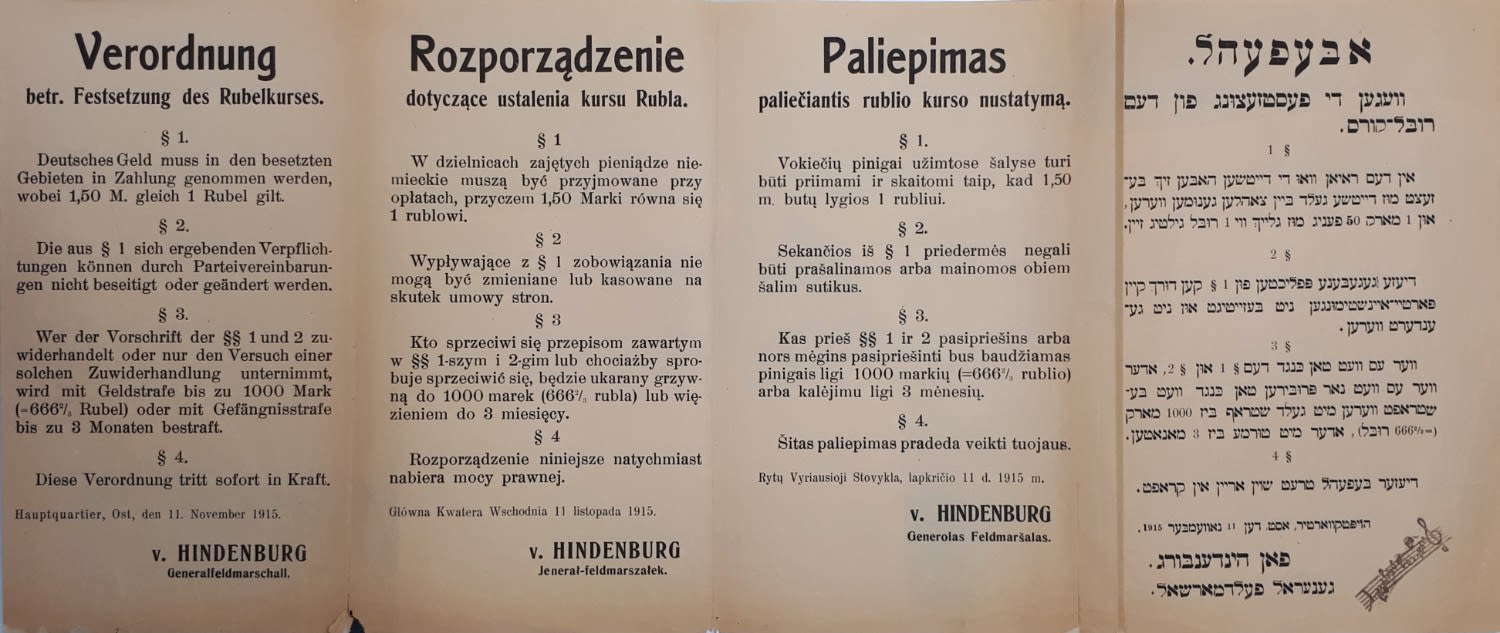
"Regulation Regarding the Correction of the Ruble Rate" a large poster in four languages in which the German occupier during the First World War informs the residents of Lithuania - the application of the German currency and its rate to the ruble in the occupied territories. Signed in print by Field Marshal Paul von Hindenburg - the supreme commander of the German forces. "Headquarters East", November 11, 1915.
In the poster, which was printed in four languages: Yiddish, Polish, Lithuanian, and German, side by side, written:
"German money must be accepted in the occupied territories according to which:
1.5 is equivalent to 1 ruble.
It is forbidden to cancel or change what is stated in section 1 by agreements.
Whoever violates the instructions mentioned in sections 1 and 2, or makes an attempt to violate them, will be punished by a fine of up to 1000 marks (=666 2/3 rubles), or by imprisonment of up to three months.
This order takes effect immediately.
Headquarters East, November 11, 1915, Hindenburg Field Marshal."
Size: 70x30 cm. general condition good.
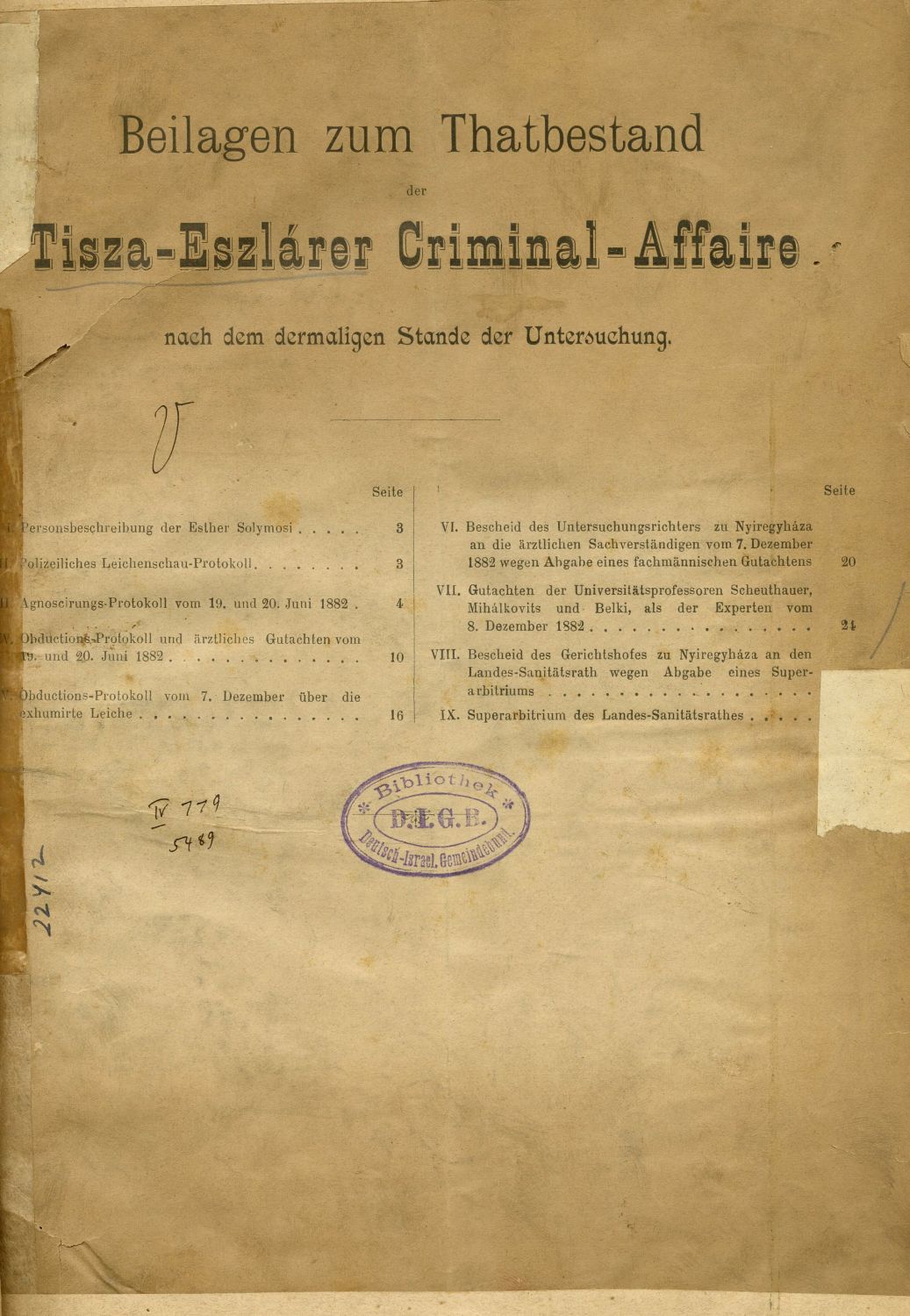
Beilagen zum Thatbestand Tisza-Eszlarer Criminal- Affaire - The criminal case of Tiszaeszlár. A report that published during the trial, and discusses in great detail the alleged evidence for accusing the Jews of the "Tiszaeszlár plot", in which a group of Jews were accused of kidnapping and murdering a Christian girl. German. The report was published during the court hearings before the sentencing, 1882-1883.
The Tiszaeszlár Affair was a blood plot, which widespread in the Hungarian town of Tiszaeszlár, after a Christian girl named Solymosi Eszter, who served as a maid in a Jewish family's home, disappeared from her home and did not return on Saturday, April 1, 1882, four days before Passover. When all means to locate her failed, a rumor began to spread in the town that the Jews had murdered her in a ritual murder and used her blood to bake matzot for Passover. On the same day, the Shamash of the community, Yosef Sharp and his wife, were arrested, along with the butcher Schwartz, and the investigation began. During the next two months, fifteen Jews were arrested as being involved in the case and imprisoned in the district city of Nirjahaza awaiting trial. False testimony was collected and a long and inflammatory legal process began, the purpose of which was to prove their guilt. The Jewish community turned to the journalist advocate and member of the Hungarian House of Representatives, Eötvös Károly, who took on the defense. During the trial, about 33 sessions of the court were held, in which all the accused and dozens of other witnesses related to the incident were questioned. In these hearings, Eötvös managed to prove that the evidence collected was false, he protested the torture used by the investigators and finally, over a year into the trial, on August 3, 1883, the trial ended with the acquittals of all the accused "for lack of evidence".
The report before us brings in great detail the discussions and conclusions surrounding the autopsy, and the examination of the various evidence based on the marks found on the body itself, the manner in which it was found near the river, the examination of the various marks in light of the evidence received, attempts to find out the allegations made against the Jews who were suspected of being involved in the murder, various accusations of the prosecution against the Jews who supposedly tried to hide evidence from the court, examination of testimonies of people who were found a short distance from the body, examination of the possibility of death by drowning, and more. The entire report is printed on the right side of each page with a blank space to the left for notes and markings.
Rabbi Yehuda Leib HaCohen Fishman's (Maimon) copy with his Ex-libris in the lining of the cover. Some pages have markings and highlights.
Extremely rare, does not appear in the world catalog of libraries "world cat".
48, 54 p. 33 cm. Slight tears at the edges of some of the pages. Restorations by pasting paper on the last pages. General condition good - moderate.

LE CHEQUE-OBSESSION - The obsession check, France, 1892. Anti-Semitic pamphlet in the format of a checkbook. Each page features a check with anti-Semitic cartoons made by the anti-Semitic cartoonist Caran d'Ache. The checkbook came out against the background of the Panama affair, in which it presents the Jews as being responsible for the biggest financial corruption affair in the 19th century - by distributing bribe checks to interested parties who would silence the government (see below).
A booklet of anti-Semitic cartoons in the format of a numbered checkbook that depicts the corruption of the Jews in the Panama affair, and accuses them of the great damages caused to France by the rule of money, and the tilting of the government to self-interested needs. 20 consecutive checks appear (each with a serial number). Each cartoon shows a costumed Jew secretly giving a bribe check to one of the government officials, and shows how the Jewish tycoon does whatever he wants and controls the political interest with his money.
The Panama scandal was a corruption case that broke out in France in 1892 in connection with the mining of the Panama Canal. A loss of close to a billion francs was recorded when the government took bribes to keep quiet about the financial problems of the Panama Canal Company, in what is considered the biggest financial corruption scandal of the 19th century. The affair created anti-Semitic waves in France, because of the involvement of two Jews of German origin: Baron Jacques de Reinach and Cornelius Herz. Although the two were not among the members of parliament who received the bribes or in the management of the company, they were accused of being responsible for the distribution of the bribe money. Before his death, Reinach gave the anti-Semitic daily newspaper La Libre Parole ("The Free Word") of the journalist Édouard Drumont a list of members of parliament expelled for speaking a crime, in exchange for covering up his own part in the affair. The story turned the newspaper overnight from an insignificant issue to one of the most influential newspapers in France. The list of partners in crime was published every morning in small installments, so that hundreds of politicians had to live in great tension for months.
The illustrator of the cartoons Caran d'Ache - pseudonym of the French cartoonist Emmanuel Poiré [1858-1909]. d'Ache arrived in France in 1877 and served in the French army for five years during which he shaped his anti-Semitic national views. And already as a soldier he drew cartoons against the German army in the magazine La Vie militaire. In 1898 he founded the anti-Dreyfus magazine "Psst...!" Together with fellow artist and designer Jean-Louis Fourn. The magazine, which consisted of 85 issues, consisted entirely of anti-Semitic cartoons against Dreyfus and his supporters.
28x13 cm. 20 pages. Cover page detached. Stains. Good condition.
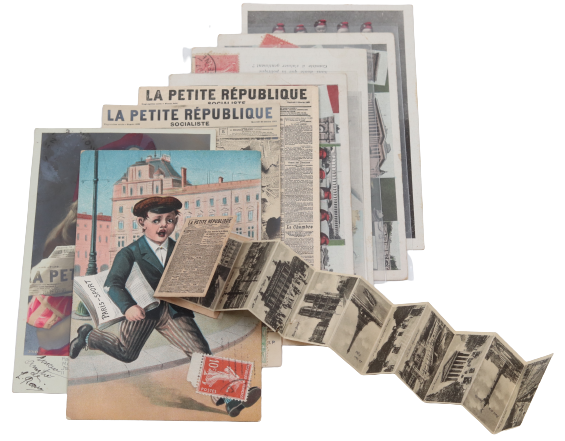
8 advertising postcards for the French newspaper "La Petite République". France, c. 1900.
In the postcards: a unique opens postcard in which a boy delivering newspapers holding "Le Petit" in his hand, from which a chain of 10 small photographs of buildings in Paris, Postcards of children's heads emerging from the newspaper or wrapped in newspaper are accompanied by short lines praising the newspaper.
The French republican newspaper La Petite République was published from April 12, 1876 to January 1, 1938 as a daily. It was founded by Alphonse Péphau. In the 1890s it was bought by Henri Turot. During the Dreyfus trial, the editor of the newspaper was Jean Léon Jaurès, who fiercely defended Dreyfus in a series of articles under the title "Proofs". Jaurès joined Emile Zola and headed the Dreyfus defenders group, against the anti-Semitic rightists. Jaurès was murdered by an assassin in August 1914.
Most of them were sent by mail. Very good condition.

Issue of the German national anti-Semitic newspaper "Jugend" - youth. Munich, February 1899.
In the issue many stories and cartoons to strengthen German nationalism, as well as anti-Semitic cartoons.
A complete sheet. Very good condition.
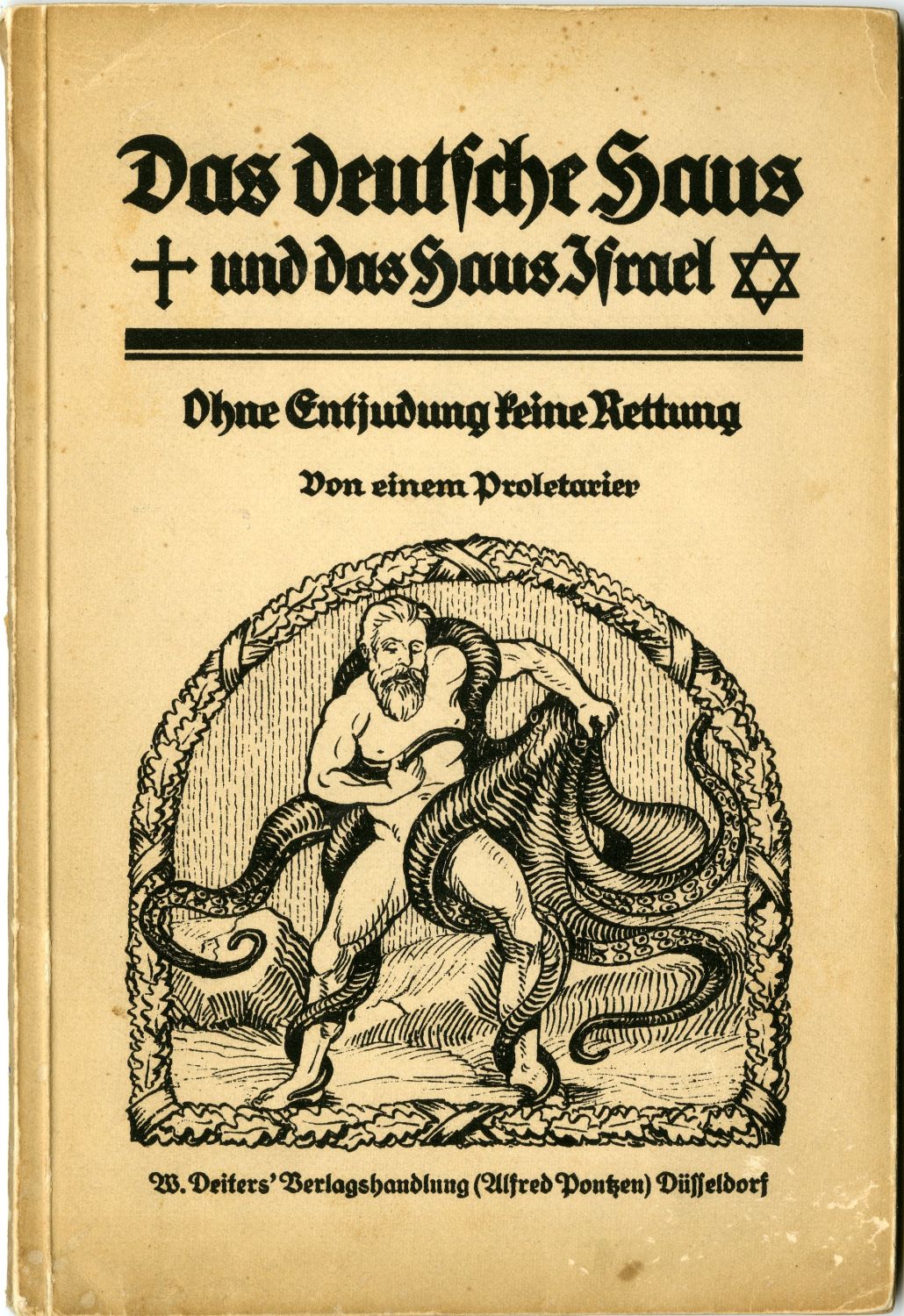
Das deutsche Haus und das Haus Israel - The German House and the House of Israel', published by the German "Proletarian". W. Deiters, Düsseldorf, 1919. From the anti-Semitic publications of the Nazi Party at the beginning of its formation.
"The global House of Israel is flourishing and the German House is desolate. This is not a coincidence... The rise of Israel and the decline of Germany did not happen suddenly, not even in a short time, but gradually and consistently over many decades..." . An anti-Semitic essay that claims that the Jewish people are prospering at the expense of the decline of the German people by taking over all the centers of power in the German state: the banks, the press, literature, art and theater. The writer even goes on to criticize the Jewish press itself, whose sole purpose is to mislead the reader, to create sensations, and to waste his time. The writer even distorts passages from the Talmud in the manner of the German anti-Semites in the 19th century, and more.
On the cover apear the anti-Semitic slogan: "Without de-Judaism there is no salvation" , and "Struggle after the collapse for our restoration" . On the cover is an anti-Semitic illustration of an octopus representing the Jewish people, which captures with its legs Aryan figure representing the German people. Star of David on the right and a cross on the left.
The message that the writer conveys at the end of the book is to unite the Germans in their war against the Jews as an interest that must be placed above all else.
76 [4] p. 23 cm. Good condition.

Das Lied vom Levi [The Song of Levi], by Dr. Eduard Schwechten. The printing house and publishing house of the anti-Semitic bookstore Eduard Hensel Cologne, 1930s. On the cover is a red ink stamp: "Prohibited".
An anti-Semitic rhyming story for children that describes the Jewish swindler Levi who grew up as a child with a bad temper and through his childhood he learns to be scheming and harm those around him, until he grows up and becomes the great enemy of Germany. At the end of the story, the author calls on the German nation to wake up against the Jews: "Nordic men full of strength and courage... A German will never be a slave to the Jews... The one who proud and noble and brave and loyal will never bow to a tyrant...".
[15] [1] p. 22 cm. Detached pages. Good condition.
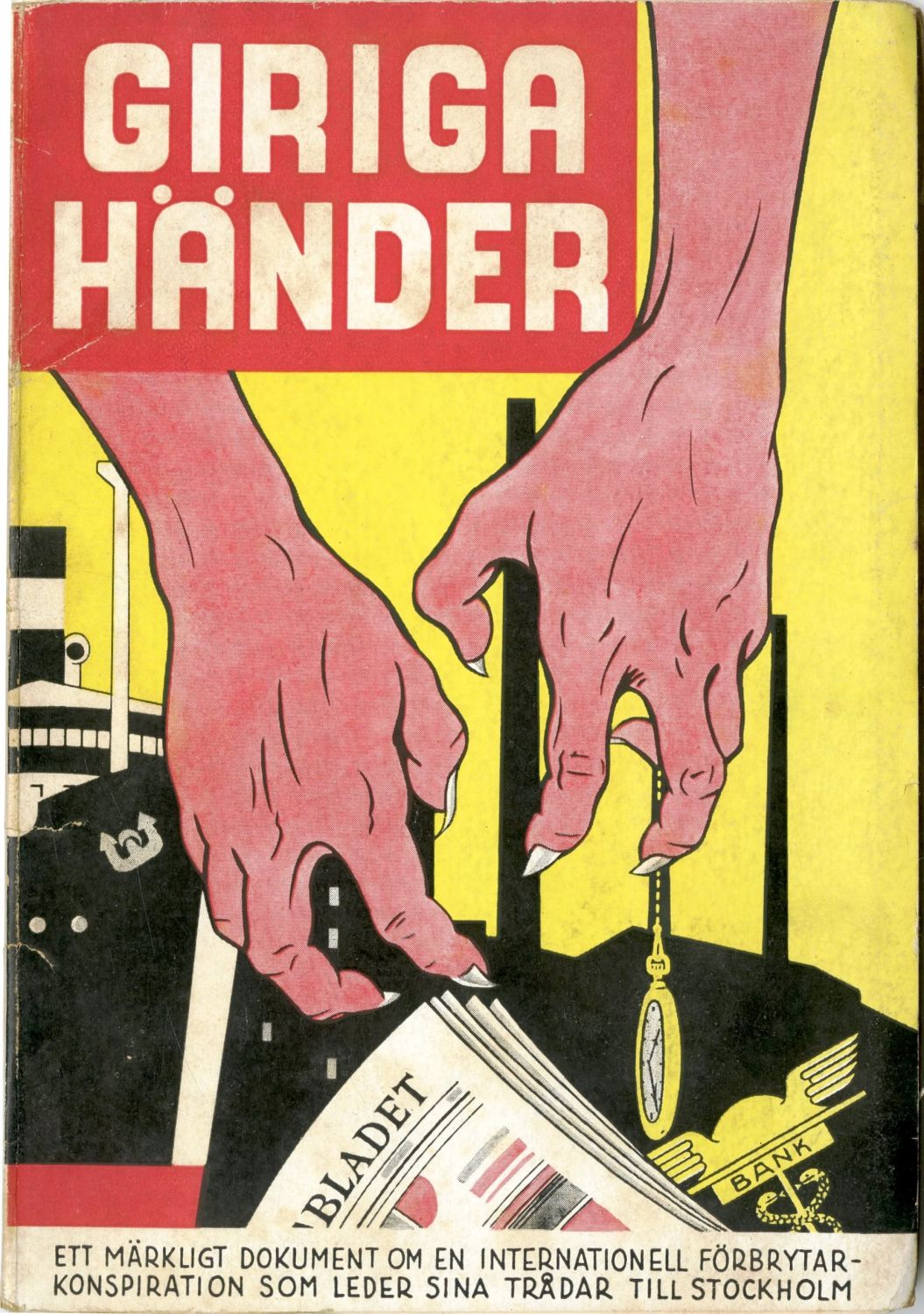
Giriga händer : ett märkligt dokument om en internationell förbrytarkonspiration som leder sina trådar till Stockholm - "Greedy Hands: A Strange Document on an International Criminal Conspiracy That Leads Its Wires to Stockholm", by Martin Brand - An anti-Semitic essay accusing the Jews of taking over the world economy in order to collapse the countries in which they live. Sweden, 1936 - first edition. Swedish.
An anti-Semitic publication that accuses the Jews [whom the author calls "the cancer of society"] of a world conspiracy with the intention of taking over the economy of the countries in which they live, collapsing them and taking them over from the inside by buying them after they are dying. The author accuses the Jews of this behavior all over the world and in particular in Stockholm by finance dynasties of Jews who lived in Stockholm for decades. He claims, among other things, that the Jews caused the death of the swedish millionaire Ivar Kreuger, who owned three-quarters of the world's production between the two wars, and died in 1932. The author describes a situation in which the Jewish banks created in Sweden a state within a state, and created a situation where the very existence of the state depends on Jewish money. In addition, the author uses the names of several large Jewish industrialists who were able to sway government decisions, and calls the Jews the owners of "global crime", and expresses a wish that his book will shock every Swede wherever he is after reading it.
rare. Only one copy appears in the world library catalog "world cat" in the library in Stockholm.
87 p. 22 cm. Many sheets were not cut in the print (connected at their edge). Very good condition.
Created and Develop with 🤍By webe ©2024